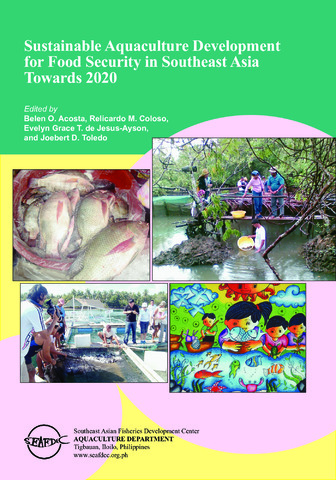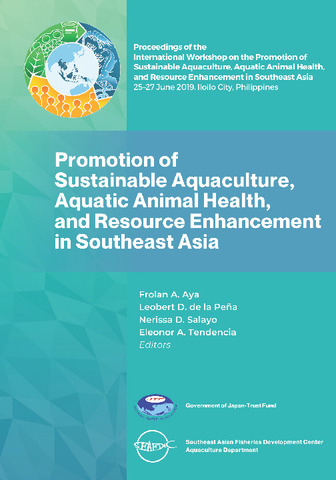| dc.contributor.author | Jumatli, Azimah | |
| dc.contributor.author | Ismail, Mohamad Saupi | |
| dc.contributor.editor | Aya, Frolan A. | |
| dc.contributor.editor | de la Peña, Leobert D. | |
| dc.contributor.editor | Salayo, Nerissa D. | |
| dc.contributor.editor | Tendencia, Eleonor A. | |
| dc.date.accessioned | 2021-12-16T01:23:56Z | |
| dc.date.available | 2021-12-16T01:23:56Z | |
| dc.date.issued | 2021-12 | |
| dc.identifier.citation | Jumatli, A., & Ismail, M. S. (2021). Promotion of sustainable aquaculture in Malaysia. In F. A. Aya, L. D. de la Peña, N. D. Salayo, & E. A. Tendencia (Eds.), Proceedings of the International Workshop on the Promotion of Sustainable Aquaculture, Aquatic Animal Health, and Resource Enhancement in Southeast Asia (pp. 31–40). Tigbauan, Iloilo, Philippines: Aquaculture Department, Southeast Asian Fisheries Development Center. | en |
| dc.identifier.isbn | 9789719931102 (Print) | |
| dc.identifier.isbn | 9789719931119 (PDF) | |
| dc.identifier.uri | http://hdl.handle.net/10862/6253 | |
| dc.description.abstract | Aquaculture has been identified as a priority sector in the development of Malaysia’s economy. It receives a wide participation as a result of the progressive development in most parts of the country. From producing only about 7% of the national fish production in 1992, aquaculture has produced almost 13% to that of capture production in 2003, and expected to produce equal volume to the latter in the future. The aquaculture production leaped from less than 80,000 metric tonnes in 1992 to more than 427,000 metric tons in 2017 valued at MYR3 billion. Demand is expected to continue to grow with anticipated population growth. Aquaculture provides employment, business and investment opportunities in this country. As of 2017, there are over 18,000 aquafarmers in Malaysia, with a total farm size of more than 34,000 ha. Two key factors i.e. the physical and financial factors, have boosted the competitiveness of Malaysia’s aquaculture industry. The National Key Economics Area (NKEA) has become a mechanism to allow big players to lead private sectors participate in this industry. This paper intends to explicate Malaysia’s aquaculture potentials with a view to provide insight prospects for aquaculture growth. | en |
| dc.language.iso | en | en |
| dc.publisher | Aquaculture Department, Southeast Asian Fisheries Development Center | en |
| dc.rights | Attribution-NonCommercial-ShareAlike 3.0 IGO | * |
| dc.rights.uri | http://creativecommons.org/licenses/by-nc-sa/3.0/igo/ | * |
| dc.subject | sustainable fisheries | en |
| dc.subject | Malaysia | en |
| dc.title | Promotion of sustainable aquaculture in Malaysia | en |
| dc.type | Conference paper | en |
| dc.citation.spage | 31 | |
| dc.citation.epage | 40 | |
| dc.subject.asfa | sustainable aquaculture | en |
| dc.subject.asfa | aquaculture | en |
| dc.citation.conferenceTitle | Proceedings of the International Workshop on the Promotion of Sustainable Aquaculture, Aquatic Animal Health, and Resource Enhancement in Southeast Asia | en |




